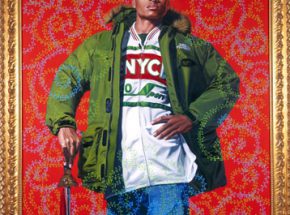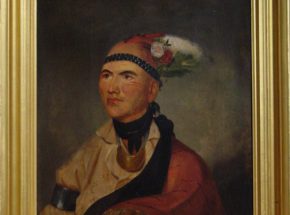

Charles Willson Peale was born in Queen Anne’s County, Maryland. He became an apprentice to a saddler in Annapolis before moving to Pennsylvania around 1764 where he studied with the German painter, John Hesselius. In Pennsylvania, he advertised as a saddler, chaisemaker, silversmith, sign painter, and clock and watchmaker and repairman. Charles Willson moved to Boston around 1768 where he furthered his career as a painter and reportedly studied with John Singleton Copley. He then went to London to study painting with Benjamin West and learned the technique of mezzotint and sculpture as well. By 1769, Charles Willson had returned to Annapolis, Maryland, for a brief stay before moving permanently to Philadelphia, Pennsylvania.
By the start of the American Revolution, Charles Willson was active in politics and the military. He served as captain of the volunteers at the Battle of Trenton, and it was during this service that he met and painted many heroes of the war, including George Washington, whom he ultimately painted fourteen times. After the war, his interest in politics continued, and in 1779, he became a representative for Philadelphia to the Pennsylvania State Legislature.
Besides politics, Charles Willson was interested in promoting the fine arts and natural history. In 1794, he established a short-lived art association called “The Columbian,” and in 1805 became one of the founding members of the Pennsylvania Academy of the Fine Arts. He also studied natural history and during an archaeological dig in 1801, he and his sons were the first to uncover a mastodon. Wishing to display many of the artifacts and animal specimens he had collected, he founded a museum that featured wildlife displayed with painted backdrops. The museum also displayed his portraits of noted Americans. It museum was originally located in the American Philosophical Society building in Philadelphia, but in 1802 moved to Independence Hall where the entire second floor was used as a portrait gallery.
Charles Willson was married three times, first to Rachel Brewer, then to Elizabeth DePeyster, and finally to Hannah Moore. He fathered seventeen children before his death in 1827.
Rembrandt Peale followed the footsteps of his father. Born in Bucks County, Pennsylvania, while his father was in an army encampment, Rembrandt began painting at a young age. He completed his first portrait in 1791, and by 1795 he had painted his first portrait of George Washington; for an account of this event, see Rembrandt’s lecture on the portraits of George Washington, accession 63×53. Having been taught by his father, the public greatly anticipated his work, but it was not well received, and Rembrandt moved to Charleston, South Carolina. In 1801, he moved to London to study with Benjamin West at the Royal Academy, but became ill and returned to the United States to take up farming, only to find himself greatly in demand as a painter. He again went abroad in 1807, this time to Paris, where he became court painter for Napoleon. He returned to Philadelphia to paint his most important work, “Court of Death,” in 1820. In 1822, he moved to Baltimore where he, along with several brothers, established the Peale Museum and Gallery. After a brief visit to France and Italy in 1829, Peale moved to New York in 1834, but later returned to Philadelphia where he spent the remainder of his life.
Besides his paintings Rembrandt Peale was noted for being a founding member of the Pennsylvania Academy of the Fine Arts in 1805, a founding member of the National Academy of Design in 1826, and one of the first artists to produce lithographs, experimenting with the process through the Pendleton Brothers of Boston as early as 1826. In his later years, Rembrandt wrote articles for periodicals, texts on painting technique, and lectured on various topics, including his father and the other portrait painters of George Washington.
Rubens Peale was Rembrandt’s younger brother. As a painter, he was noted for his still life and animal paintings, but his weak eyes prevented him from a long career as a professional artist. Instead, Rubens worked as the manager of the Peale Museum in Philadelphia from 1810-1822. In 1822, he moved to Baltimore with his brothers to found the Peale Museum there, which he directed until 1825. Rubens then went to New York City to establish another Peale Museum, which he operated until it was financially ruined by the Panic of 1837. Rubens returned to Philadelphia where he resided on his father’s estate until his death.
http://findingaid.winterthur.org/html/HTML_Finding_Aids/COL0396.htm

